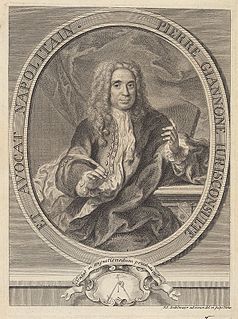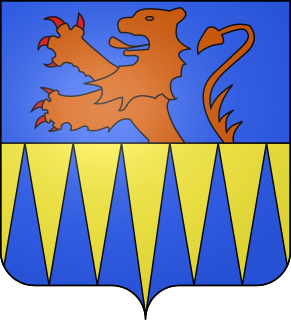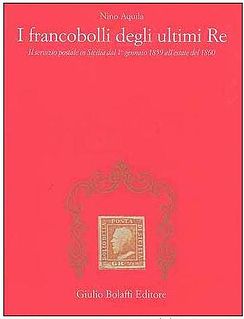
Pietro Giannone was an Italian philosopher, historian and jurist born in Ischitella, in the province of Foggia. He opposed the papal influence in Naples, for which he was imprisoned for twelve years until his death.

The Prince of Belmonte is a noble title created in 1619 by the Spanish crown for the Barons of Badolato and Belmonte.

Carlo Fecia di Cossato was an officer in the Regia Marina, in command of submarines and torpedo boats during World War II. He was credited with the confirmed sinking of 23 enemy ships. He was also a recipient of the Knight's Cross of the Iron Cross and of the Gold Medal of Military Valor, the highest decoration of the Italian Armed Forces.
Orazio Giovan Battista Ravaschieri Fieschi was a wealthy nobleman and patrician ('patrizio') of Genoa descending from the Fieschi, Counts Palatine of Lavagna, in what is now Liguria. He was appointed Grand Seneschal of Naples, and, on 5 March 1619, he was elevated to the title of Prince of Belmonte at Madrid by Philip III of Spain. Orazio descended from a line of imperial and royal bankers, his great-grandfather Giovan Battista and grandfather having been Treasurers to Charles V, Holy Roman Emperor, and King Philip II of Spain respectively.

Line 2 is a commuter rail service operated by Trenitalia in the city of Naples, Italy. It connects 12 stations.
Between 1851 and 1860, Grand Duchy of Tuscany, an independent Italian state until 1859 when it joined the United Provinces of Central Italy, produced two postage stamp issues which are among the most prized classic stamp issues of the world, and include the most valuable Italian stamp.

The postal history of San Marino can be traced to October 7, 1607, with the introduction of public postal services. The republic’s postal needs were handled by a post office in nearby Rimini, Italy; the first San Marino post office opened in 1833.
Dr. Emilio Diena, was an Italian philatelist who specialized in the postage stamps of Italy and published substantial research on the subject. He was probably the best known Continental philatelist of his generation.
This is a survey of the postage stamps and postal history of Eritrea.
The following is a survey of the postage stamps and postal history of Somalia. From the late 1800s to 1960, northwestern present-day Somalia was administered as British Somaliland, while the northeastern, central and southern part of the country were concurrently administered as Italian Somaliland. In 1960, the two territories were unified as the Somali Republic.

The church of Santi Severino e Sossio and the annexed monastery are located on via Bartolommeo Capasso in Naples, Italy.

Dr. Nino Aquila was an Italian philatelist who, in 1990, was awarded the Crawford Medal by the Royal Philatelic Society London for his work I francobolli degli ultimi Re: Il servizio postale in Sicilia dal 1° gennaio 1859 all’estate del 1860. Aquila was an expert on the philately of Sicily.
The Conspiracy of Macchia or Congiura di Macchia was a three-day uprising occurring in Naples in 1701, immediately after the ascension of the first Bourbon monarch to the Spanish throne, an event that precipitated the War of the Spanish Succession. In this short revolt, Neapolitan nobles attempted to seize control of the kingdom from the Spanish viceroy, but failed.
Alberto Basso is an Italian musicologist.

Castelluccio culture is an archaeological feature dating to Ancient Bronze Age of the prehistoric civilization of Sicily, originally identified by Paolo Orsi on the basis of a particular ceramic style, in the homonymous village, between Noto and Siracusa.

Paolo Panceri was an Italian naturalist. Panceri graduated in medicine at the University of Pavia where he began his research. In 1861 he took the Chair of Comparative anatomy at the University of Naples, where he directed the Zoology Museum. Panceri was cautious about the scientific validity of evolutionary theories but was instrumental in the foundation of the Stazione Zoologica Anton Dohrn .His findings on the bioluminescence of marine invertebrates and studies of Amphioxus led to fame in Italy and abroad. In 1874 he sold his books and scientific papers to Biblioteca Universitaria di Napoli to pay for an expedition to Egypt. They constitute an example of a nineteenth-century library specializing in the natural sciences and comparative anatomy. His students in Naples include Carlo Emery, Leopoldo Maggi and Antonio della Valle.He died aged 44.
The following is a timeline of the history of the city of Bari in the Apulia region of Italy.

The Royal Society of Encouragement to Natural Sciences of Naples was a XIX-century learned society, established in the Kingdom of Naples during the rule of king Joseph Napoleon at the beginning of the XIX century. His activity, with different denominations, lasted until the first decades of the XX century; it was officially closed in the 1930s, most likely in 1937. Its seat over the whole XIX century was Palace Spinelli di Tarsia, located in piazzetta Tarsia, Naples.
Biagio Cusano was an Italian Marinist poet and professor of law. The place and date of his birth are currently unknown. He is best known for being Gennaro Cusano's uncle and Marcello Papiniano Cusani's grand uncle.












